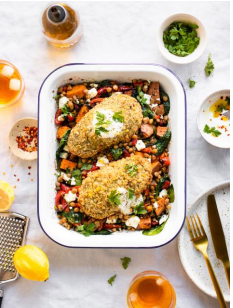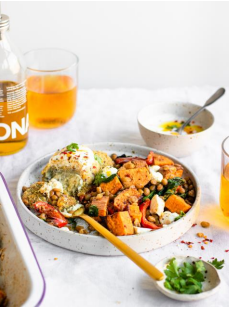
The best business & lifestyle stories from the North East and Yorkshire sent directly to you
The cold and flu season is upon us! Whilst we can’t eliminate our risk of falling ill, enjoying healthy
meals can give our body and our immune system the best chance to doing its job. Yet according to a
2021 survey commissioned by Goodlife, 39% of Brits struggle with healthy meal inspiration whilst 25%
often don’t have the right ingredients to hand.
Whether you’re a regular cook or a novice in the kitchen, this shopping list of immunity foods shared
by leading nutritionist, Lily Soutter, will help to keep you and your immune system in tip-top shape
this autumn and beyond…
Did you that 70% of the immune system lies within the gut, and our gut bacteria communicates with
these immune cells influencing their action. Fibre acts like fertiliser for our healthy gut bacteria, helping
them to flourish and grow. However, as a population, we are consuming only half of our daily fibre
target! What’s more, Goodlife’s 2021 survey showed that 35% of us are not sure how much fibre we
should be consuming as well as the foods we should be choosing! The simplest way to boost our intake
is to enjoy some veggie meals each week. Thankfully beans and pulses are jam-packed full of fibre and
are affordable too
Top tip: Short on time? Goodlife’s Non-Meaty Sausages are filled with a blend of lentils and delicious
veggies which can really pack in that fibre punch!
2. Red Bell Peppers
Did you know that red bell peppers contain more vitamin C per 100g in comparison to oranges? This
antioxidant nutrient is required for the production of white blood cells, which produce antibodies that
help fight off viruses. Because our body cannot manufacture vitamin C, we must top up our daily stores
from the food we eat. Other great sources include kiwi fruit, strawberries, broccoli and Brussel sprouts
Top tip: vitamin C is a water-soluble nutrient that is destroyed by heat. Lightly steaming or microwaving
your vegetables appears to retain higher concentrations of vitamin C in comparison to boiling.
3. Soybeans
Soybeans, tofu and tempeh are great plant-based sources of iron. A 100g serve of tempeh provides
3.6mg iron whilst cooked edamame beans provide 2.7mg! Iron is an important nutrient within the diet
and a low status has been shown to suppress immunity. Women of childbearing age and teenage girls
need to be particularly mindful of meeting their daily dietary targets as they require more than men
and postmenopausal women (14.8 mg/day vs 8.7mg/day).
Top tip: the absorption of iron found in plant-based foods is often reduced due to dietary phytates. But
fear not, the absorption of iron from the gut can be boosted by combining your iron source with vitamin
C rich foods such as fruit and vegetables.
4. Sweet Potato
Beta-carotene is the phytonutrient responsible for the bright orange hue of sweet potato. This nutrient
converts to vitamin A within the body and is needed for the maintenance of healthy epithelial cells
which line the gut, eye and respiratory tract. These cells form a mucosal lining which acts as the first
line of defence against infection.
Top tip: beta-carotene is fat-soluble therefore combining your sweet potato with healthy fats such as
olive oil or avocado can increase how much you absorb.
5. Brazil Nuts
These delicious nuts are native to the Amazon rainforest and are a concentrated source of selenium.
In fact, research has shown that consuming just two Brazil nuts a day is highly effective at raising
selenium status. Selenium is a trace element with antioxidant properties which help to fight oxidative
stress and enhance our immune function.
Top tip: the concentration of selenium in Brazil nuts can vary widely as it depends on the status of the
soil and where they’ve been grown. To reduce the risk of selenium toxicity, limit your daily intake of
Brazil nuts to 1-3 per day.
6. Eggs
Did you know that eggs are one of the few food sources of vitamin D3? This sunshine vitamin is a key
nutrient required for immune regulation. As many as 1 in 5 people have low vitamin D levels within the
UK, and during Oct-April we should all consider supplementing with 10mcg per day. Vitamin D3 lies
within the egg yolk so remember not to throw this delicious part away!
Top tip: research has shown that free-range eggs have 3-4 times the amount of vitamin D compared
to battery farmed eggs. This is because the hens have a chance to roam outdoors in the sunlight.
7. Spinach
Dark green leafy vegetables such as spinach really pack in a powerful punch due to their abundance of
nutrients and minerals. Spinach provides us with both iron, beta carotene and antioxidant
phytonutrients which can support the normal function of the immune system. If you’re not a fan,
Goodlife’s non-meaty sausages are jam-packed full of veggies including spinach. What an easy way to
eat your greens!
Top tip: serve your spinach with a lemon juice and olive oil dressing to boost the bioavailability of the
immune support nutrients.
8. Pumpkin Seeds
Pumpkin seeds are a good source of dietary zinc, an essential mineral that helps to keep the immune
system strong. Zinc may help to inhibit the replication of the rhinovirus, which is the most frequent
cause of cold symptoms. The ability to absorb zinc from plant-based foods is not as efficient as from
animal sources therefore if following a vegan or veggie diet aim to consume plenty of zinc-rich foods
such as pumpkin seeds, wholemeal bread, beans, and nuts.
Top tip: Did you know that heating, sprouting, and pre-soaking legumes, nuts and seeds as well as
fermenting grains (like sourdough bread) can increase our ability to absorb zinc?
9. Fermented Foods
Fermented foods such as yoghurt with live cultures, kefir, kombucha, and even sauerkraut can
introduce beneficial bacteria to the gut. These bacteria can communicate with the immune cells in our
gut influencing their function. Whilst research is still in its infancy regarding the benefits of fermented
foods, some studies have shown that taking probiotic supplements may reduce the severity of upper
respiratory tract infections for those under physiological stress such as athletes. Nevertheless, enjoying
a daily dose of fermented goodness is a perfect way to give your diet a boost
Top tip: fermenting foods can help to improve the bioavailability of immune support nutrients such as
iron and zinc.
10. Sun-Ripened Mushrooms
Did you know that mushrooms can produce vitamin D2 when exposed to sunlight? This nutrient
contributes to the normal function of the immune system and sun-exposed mushrooms are one of the
few vegan sources. You can boost the vitamin D content of your mushrooms at home. Simply lay them
in the sun gill side up between 10-3 pm for 15-20 mins. You could end up with over 10 mcg vitamin D
per 100g mushrooms which is a substantial portion of our daily recommended intake! However, it is
important to note the time of day, season, latitude, weather conditions and exposure time can help or
hinder vitamin D production.
Top tip: Short on time? Simply pop into your supermarket and look for the label ‘UV treated’ or ‘vitamin D’ enriched mushrooms.


For delicious recipe inspiration, more helpful advice and to browse the full range of delicious
veggie and vegan products available, visit www.goodlife.co.uk.